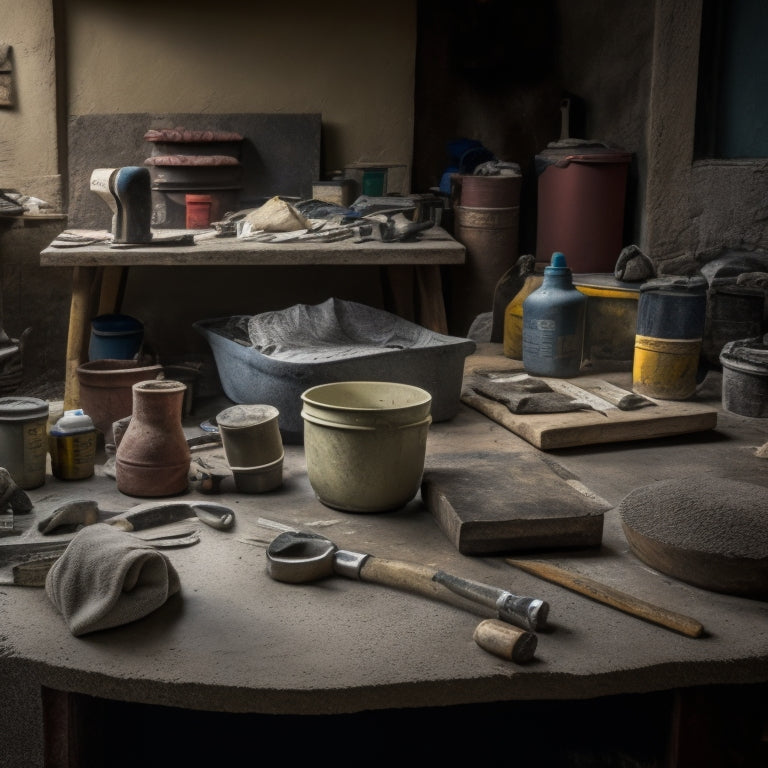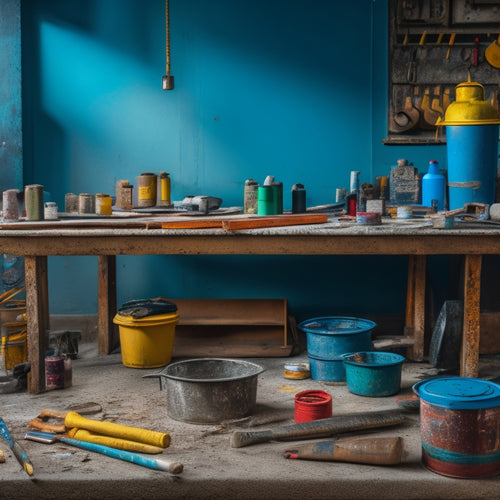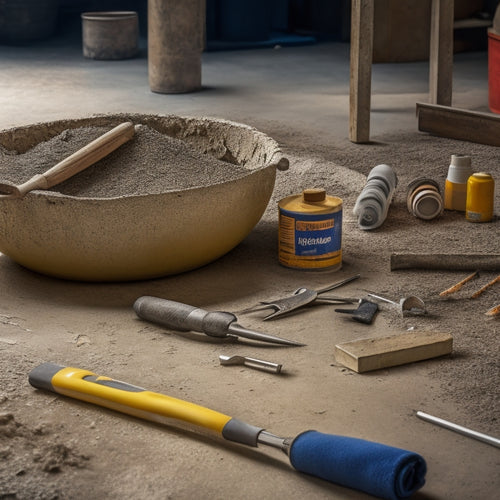
5 Best Plastering Tools for Stamped Concrete Walls
Share
When working with stamped concrete walls, you'll need five specialized tools to achieve a flawless, realistic finish. First, you'll need a top-rated trowel for a smooth finish, with an ergonomic handle and high-quality materials like stainless steel or high-carbon steel. Next, select the best stamps for your desired texture pattern, considering scale, intricacy, and durability. Essential edging tools, premium floats, and high-quality darbies will round out your arsenal, ensuring crisp lines, even surfaces, and a professional finish. With the right tools, you'll be well on your way to excelling in the art of stamped concrete walls - and it's just the start of your expedition to perfection.
Key Takeaways
- Top-rated trowels with ergonomic handles provide precise control and maneuverability for a smooth concrete finish.
- Best stamps for texture patterns offer realistic designs, durability, and versatility for achieving unique concrete wall finishes.
- Essential edging tools, including corner trowels and precision edgers, ensure crisp, clean lines and defined edges on stamped concrete walls.
- Premium floats, made from materials like aluminum, resin, or magnesium, are necessary for flattening and smoothing concrete surfaces.
- High-quality darbies with durable materials, ergonomic design, and pattern variety provide the finishing touches for customized stamped concrete wall projects.
Top-Rated Trowels for Smooth Finish
What makes a trowel top-rated for achieving a smooth finish on stamped concrete walls?
You'll want a trowel that's made from high-quality materials, such as stainless steel or high-carbon steel, which provide the necessary strength and durability for working with thick concrete mixes.
A top-rated trowel should also have a comfortable, ergonomic handle that allows for precise control and maneuverability.
When it comes to trowel techniques, you'll want to focus on using a steady, consistent motion to spread and smooth the concrete.
This involves holding the trowel at a 20- to 30-degree angle and applying gentle to moderate pressure, depending on the concrete's consistency.
As you work the concrete, use long, sweeping strokes to achieve an even, uniform finish.
Best Stamps for Texture Patterns
Pick up the right stamp and you'll be well on your way to creating realistic texture patterns on your stamped concrete walls. With numerous stamp options available, selecting the best one for your project can be overwhelming.
However, understanding the different types of stamps and their applications can help you make an informed decision. For decorative patterns, you'll want to opt for texture stamps with intricate designs, such as stone or brick patterns. These stamps provide texture variation, allowing you to achieve a realistic, three-dimensional appearance.
You can also use combination stamps that feature multiple patterns in a single stamp, offering greater versatility. When choosing a stamp, consider the scale and intricacy of the pattern you want to achieve. Larger stamps are ideal for creating bold, statement patterns, while smaller stamps are better suited for more subtle, detailed designs.
Additionally, look for stamps made from durable materials, such as urethane or polyurethane, which can withstand heavy use and provide a consistent texture. By selecting the right stamp for your project, you'll be able to achieve professional-looking results with minimal effort.
Essential Edging Tools for Corners
Corners are notoriously tricky areas to stamp, as they require precise control and manipulation of the stamping tool. Achieving professional-looking corner detailing demands the right edging tools, which can make all the difference in the final product's overall appearance.
To get it right, you'll need:
- A corner trowel with a curved or angled blade, perfect for maneuvering tight spaces and maintaining edge precision
- Edge guides or corner templates to guarantee accurate stamp placement and prevent mistakes
- A precision edger for creating crisp, clean lines and defined edges
- A corner chisel or stamping tool specifically designed for corner work, allowing for precise manipulation and control
- A rubber edge scraper for removing excess concrete and creating a smooth finish
With these essential edging tools in your arsenal, you'll be able to tackle even the most challenging corners with confidence. Achieving the level of precision and detail required for exceptional stamped concrete walls will be within your reach.
Premium Floats for Even Surface
As you've perfected the art of edging, it's time to focus on achieving an even surface, an essential component of stamped concrete walls. To accomplish this, you'll need premium floats that can effectively flatten and smooth out the concrete.
When selecting a float, consider the float materials that suit your project's requirements. Aluminum floats are ideal for large, open areas, while resin floats are better suited for smaller, more intricate spaces. Additionally, magnesium floats offer a high-quality, durable option for both large and small projects.
Mastering float techniques is also vital for achieving an even surface. Start by holding the float at a 45-degree angle and applying gentle pressure. As you move the float, maintain consistent pressure and use long, smooth strokes to cover the entire area.
Avoid applying too much pressure, which can create unevenness or even damage the concrete. By combining the right float materials with expert float techniques, you'll be able to achieve a smooth, even surface that sets the stage for a beautifully stamped concrete wall.
High-Quality Darbies for Finishing Touches
With your smooth, even surface in place, you're ready to turn your attention to the finer details of your stamped concrete wall. High-quality darbies are essential for achieving a professional finish. These tools allow you to add texture, pattern, and definition to your wall, giving it a unique and visually appealing appearance.
When selecting darbies, consider the following key factors:
-
Material selection: Choose darbies made from high-quality materials that can withstand the demands of your project. Look for durable, rust-resistant materials that will maintain their shape and performance over time.
-
Technique versatility: Opt for darbies that can be used with various techniques, such as stamping, stenciling, or texturing. This will give you the flexibility to experiment with different designs and patterns.
-
Ergonomic design: Select darbies with comfortable, ergonomic handles that reduce fatigue and improve control.
-
Pattern variety: Choose darbies that offer a range of patterns and textures, allowing you to customize your design to suit your project's unique requirements.
-
Maintenance ease: Consider darbies with easy-to-clean designs and minimal maintenance requirements, ensuring your tools remain in top condition throughout the project.
Frequently Asked Questions
Can I Use a Single Tool for Both Plastering and Stamping Concrete Walls?
You can't use a single tool for both plastering and stamping concrete walls, as plastering techniques require smooth, even application, while stamping methods demand textured, patterned impressions, requiring specialized tools for each process.
How Do I Clean and Maintain My Plastering Tools for Longevity?
Are you willing to sacrifice your tools' performance for convenience? You shouldn't. Clean your tools with mild cleaning solutions, store them properly in designated tool storage, and you'll extend their lifespan, ensuring peak performance for your next project.
Are There Any Specific Safety Precautions for Working With Plastering Tools?
When working with plastering tools, you must prioritize tool safety and personal protection. Wear protective gear like gloves, safety glasses, and a dust mask to prevent injuries and exposure to hazardous materials.
Can I Hire a Professional to Apply Stamped Concrete Finishes Instead?
Imagine your dream design unfolding like a masterpiece; yes, you can hire an expert to apply stamped concrete finishes, leveraging the benefits of durability and low maintenance, while ensuring a flawless, professional application that exceeds your expectations.
How Long Does It Typically Take to Complete a Stamped Concrete Wall Project?
You'll spend around 3-5 days completing a stamped concrete wall project, considering the project timeline, which depends on material considerations like concrete curing time, stamp pattern complexity, and the number of coats required.
Conclusion
You've invested in the best plastering tools for your stamped concrete walls, but you're worried they might not deliver the professional results you need. Don't be. With these top-rated trowels, stamps, edging tools, floats, and darbies, you'll achieve a flawless finish that rivals the pros. These tools are designed to work together seamlessly, ensuring every detail - from texture patterns to even surfaces - is perfected. So, get ready to impress clients and elevate your reputation with stunning, high-quality stamped concrete walls.
Related Posts
-

Essential Tools for Painting Concrete Walls
When painting concrete walls, you'll need a range of specialized tools to achieve a professional-looking finish. Star...
-

Top Tools for Repairing Cracked Concrete Surfaces
When tackling a cracked concrete surface repair, you'll need the right tools to guarantee a durable fix. Start with e...
-

Best Tools for Concrete Restoration and Repair
When tackling concrete restoration and repair projects, you need a range of reliable tools to achieve professional-gr...


